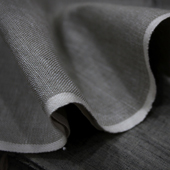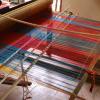Manufacturing of cloth involves several processes. These processes can be broadly categorized as pre-loom process, loom process and post-loom process.
The production process starts with scouring process. Scouring is the treatment of cotton with alkalis to remove wax, oil and other impurities, this makes the fiber more absorbent. During the scouring process fats are broken down to soap and glycerin, proteins are converted into water-soluble, wax & oil are emulsified and mineral matter & impurities are removed. Once the scouring process is over the yarns are taken for washing in a pool of acetic water to make the alkalis inactive which is used during the scouring process. Then the yarns are taken for bleaching. Bleaching is the process of removing the natural coloring agent present in the fiber to improve luster and absorbance. In Kannur handlooms, most of the co-operative societies use hydrogen peroxide as a bleaching agent. Hydrogen peroxide is the universal bleaching agent and it is used extensively for bleaching cotton. Once the bleaching is done it is washed in acetic water and taken to a squeezing machine for squeezing and after squeezing the yarns are laid on bamboo rods and kept under the sun for drying. After drying the yarns are taken for beating on a wooden frame to make them fine and to remove curls, tangles and knots.
In pre loom process dyeing solution preparation is the most tedious process. The dyeing master should be a skilful, patient and vigilant person. Most weaving societies are using vat dyes. The name vat was derived from the large wooden vessel from which vat dyes were first applied. Vat dyes provide textile materials with the best color fastness of all the dyes in common use. The fibers most radiantly colored with vat dyes are natural and manmade cellulosic fibers. Once the dyeing solution is ready, the yarns are slowly dipped into the tub for dyeing bath. Dyeing may take 15minute to 1hour 30minute depending upon the color density required. After the completion of the dyeing process the dyed sample is collected for color matching test and if the dyed sample is matching to the required color then the yarns are undergone through several washing and dried under shadow to avoid color fading. The most appreciable fact about Kannur handloom industry is that, most of the societies follow a sustainable production process. The most spectacular and appreciable sustainable model adopted by societies are waste management. After dyeing the waste water is filtered with the help of effluent treatment plant and later on the clean water is used for growing vegetable within the campus. These vegetable are used in the weaver’s canteen.
The weaving starts with bobbin winding, bobbin winding the process of winding required amount of yarn used for weaving on a big spool called bobbin. Later on the winded bobbin are taken to warp winding room where the craftsmen will arrange the bobbin according to the pattern and design on creel and thread each yarn through an equipment called comb. Once the treading is done it is winded on warping mill on a particular manner. These winded yarns are formed into a ball shape and taken for spreading on a warp beam with the help of raddle. The appreciable fact is each any every steps of production has equivalent involvement of men women. Once the winded beam is set on the back of loom and craftsmen head towards the most tedious work of the whole weaving process: threading the warp through the heddles on the shafts. Each warp thread must go through the eye of a heddle attached to the appropriate shaft, according to the pattern design. If a mistake happen here, there will be an unsightly break in the pattern. Afterwards the yarns are drawn through the reed with reed hook and simultaneously artisans would do the pirn winding for weft. A pirn or quill is a weft bobbin that is placed inside a shuttle in shuttle weaving. As the shuttle travels back and forth across the width of the shuttle loom, the weft yarn is unwound from the pirn through the eye of the shuttle and lay in the shed. The yarn on the quill is tapered at one end such that the yarn with drawl takes place continuously without entanglement. Then the master craftsmen show their extensive talent of weaving fine fabrics which takes the name and fame of Kannur handlooms into the skyscrapers and glorifies it.




